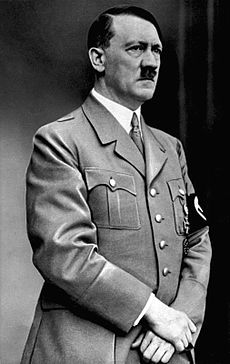World War II in Germany
The tremendous dislocations caused by World War I laid the groundwork for the collapse of democratic institutions in Germany. A worldwide depression that began in 1929 destroyed the already fragile democratic regime there.
In 1933, Adolf Hitler led to power the National Socialist German Workers' Party -- the Nazi Party -- a mass movement that was virulently nationalistic, anti-democratic, and anti-Semitic. Hitler ended parliamentary government and assumed dictatorial powers.
The Nazi government increased the strength of the German armed forces and sought to overturn the Versailles Treaty, to recover German territory lost at the peace settlement, and to return to the so-called Fatherland German-speaking minorities within the borders of surrounding countries. Hitler stated goal was to secure "living space" for the German "master race."
In March 1938, Germany invaded and annexed Austria.
In March 1939, Germany invaded Czechoslovakia.
In August 1939, Germany and the USSR signed a secret non-agression pact dividing up Poland. On September 1, Germany invaded Poland.
On September 3, 1939, Britain, France, Australia and New Zealand declared war on Germany. World War II had begun.
In late April 1945 the Soviets reached Berlin. Hitler killed himself and the last of the German resistance gave up a few days later. Mussolini had been killed by Italian partisans on 28 April 1945 while attempting to escape into Switzerland.
The Axis was defeated.
Casualties:
Military |
Civilian |
Total |
3,500,000 |
700,000 |
4,200,000 |

Adolf Hitler (4/20/1889 - 4/30/1945) was an Austrian-born German politician and the leader of the Nazi Party. He was chancellor of Germany from 1933 to 1945 and dictator of Nazi Germany from 1934 to 1945